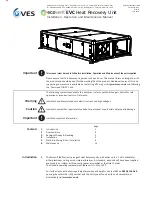
17
You will now normally add the first hop addition, bittering hops to
the boiling wort. The added hops can also result in the formation
of foam and subsequently an boil-over condition.
Tip: You can place a mixing paddle or something similar across the
top of the brew kettle as this can help break the tension of the foam
forming, hence reducing the likelihood of the wort boiling over.
The boil should be a “rolling boil”. You can adjust the brew
controller heating power setting for the boiling phase (
III
) to
achieve this. The default value is 80%. Increase to 90% or even
100% for a more vigorous boil, or reduce below 80% if the boil
is still too vigorous.
During the first 5-20 minutes of boiling a “hot break” will occur.
This is when the proteins in the wort clump together and sink to
the bottom. After a “hot break” the amount of foam will be less,
and there is a smaller risk of experiencing a boil-over condition.
Do NOT put the lid on during the boiling phase. During the
boiling of the wort some sulfur compounds (DMS) are formed,
and they are supposed to boil off. If they do not boil off, they
can cause unfavourable flavours and aroma in the beer such as
cabbage or corn.
It is normal to loose about 10 % of the wort volume during
boiling because of evaporation, depending on the boiling time,
how vigorous the wort is boiled and the air humidity.
Caution: Do not boil your wort indoor without proper
ventilation.
Add the rest of you hops and other ingredients to your boiling
wort, according to your recipe. Non-dissolvable ingredients,
such as lemon grass, orange peel or whole hop cones should be
placed in a hop bag or something similar. This is to prevent larger
objects to clog up the pump, pipes or tap.
With 15 minutes remaining of the boiling time, insert the
immersion chiller into the brew kettle. This will sanitize the
immersion chiller steel tubing. Start out by first connecting one
end of a garden hose style tubing to a cold water tap, and the
other end to the inlet of the immersion chiller. Then connect
another hose to the immersion chiller outlet. The open end of
the hose shall be placed in an open drain or in a sink.
With 5 minutes of the boiling time remaining, attach the
whirlpool pipe to the riser pipe. Open the riser pipe valve and
start the pump to sanitise the pump and pipes. Be aware of air
coming out of the whirlpool pipe as it can cause splashing of
boiling wort.
When the boiling process is complete, an audible signal will
sound and the brew controller will switch itself off.
Cooling:
With the immersion chiller already placed in the brew kettle,
open the cold water tap and allow cold water to flow through the
immersion chiller. The first water coming out of the chiller hose
will be hot, then gradually get colder as the wort gets colder.
The pump can continue to run, creating a whirpool movement in
the brew kettle. This movement of wort around the immersion
chiller pipe will contribute to even faster cooling. It is possible
to cool without the pump running, but the cooling time will
increase.
During cooling the clumped proteins and particles from the
hops will sink to the bottom. This process is called cold break,
and the mix is called trub. The trub can get into you pipe and
clog the pump preventing further circulation. If switching the
pump off and back on again does not solve the clogging problem,
switch off the pump and disconnect the whirlpool arm. Using the
hose from the lid, connect the hose to the riser pipe and blow
into the hose. This may move any stuck fragments or trub from
the pump and push it back into brew kettle. Be aware of any
splashing in the brew kettle caused by the air you blow into the
hose.
TIP: Please note that the temperature in the display will continue
to show the current temperature reading. With the sensor in the
bottom of the brew kettle covered by trub, the trub will function
as an insulator thus preventing the sensor from reading the actual
temperature in the wort. You may therefore use an external
thermometer to check the actual temperature of the wort.
Note: anything coming in contact with the wort when its
temperature is less than 70°C should first be sanitised.
Continue to cool down the wort until its temperature reaches
your yeast pitching temperature, normally 25°C (check the
recommendation for your yeast or recipe). You can now switch
off the pump. Open the tap ball valve to transfer the wort
into you fermenting vessel. Add the yeast to your wort. Close
the fermenting vessel and add an air-lock. Remember to add
some water to air-lock. Shake the fermenting vessel to mix
oxygen into the wort. Leave the wort to ferment at the desired
temperature.
You can read more about the bottling and kegging process later
in this user manual.
Note: Although debated, getting trub into your fermenting
vessel will normally not cause any unfavourable flavor or aroma
to your finished beer. Trub will sink to the bottom together
with most of the yeast after the fermentation has finished.
Tip: Add some water to the air-lock before using.
You have now finished brewing and it is time to empty and clean












































